ב-Android 14 יש תכונות וממשקי API מצוינים למפתחים. המאמרים הבאים יעזרו לכם להבין את התכונות של האפליקציות ולהתחיל להשתמש בממשקי ה-API שקשורים אליהן.
רשימה מפורטת של ממשקי API שנוספו, שונו או הוסרו מופיעה בדוח ההבדלים בין גרסאות ה-API. פרטים על ממשקי API שנוספו זמינים בהפניה ל-Android API. ב-Android 14, אפשר לחפש ממשקי API שנוספו ברמת API 34. כדי לקבל מידע על תחומים שבהם שינויים בפלטפורמה עשויים להשפיע על האפליקציות שלכם, כדאי לעיין בשינויים בהתנהגות ב-Android 14 באפליקציות שמטרגטות ל-Android 14 ובכל האפליקציות.
אינטרנציונליזציה
העדפות שפה לכל אפליקציה
Android 14 扩展了 Android 13(API 级别 33)中引入的按应用设定语言功能,并包含以下额外功能:
自动生成应用的
localeConfig:从 Android Studio Giraffe Canary 7 和 AGP 8.1.0-alpha07 开始,您可以将应用配置为自动支持各应用语言偏好设定。Android Gradle 插件会根据您的项目资源生成LocaleConfig文件,并在最终清单文件中添加对该文件的引用,这样您就不再需要手动创建或更新该文件。AGP 使用应用模块的res文件夹中的资源以及任何库模块依赖项来确定要在LocaleConfig文件中添加的语言区域。动态更新应用的
localeConfig:使用LocaleManager方法中的setOverrideLocaleConfig()和getOverrideLocaleConfig()可以在设备的系统设置中动态更新应用的受支持语言列表。有了这种灵活性,您可以按区域自定义支持的语言列表、运行 A/B 实验,或者如果您的应用通过服务器端推送进行本地化,则可以提供更新后的语言区域列表。输入法 (IME) 的应用语言可见性:IME 可以利用
getApplicationLocales()方法查看当前应用的语言,并将 IME 语言与该语言进行匹配。
Grammatical Inflection API
3 מיליארד אנשים דוברים שפות עם מגדר: שפות שבהן קטגוריות דקדוקיות – כמו שמות עצם, פעלים, שמות תואר ומילות יחס – משתנות בהתאם למגדר של האנשים והאובייקטים שאתם מדברים אליהם או עליהם. באופן מסורתי, בשפות רבות עם מגדר נעשה שימוש במגדר grammatcal masculine כמגדר ברירת המחדל או כמגדר כללי.
שימוש במגדר הדקדוקי הלא נכון למשתמשים, למשל שימוש במגדר הדקדוקי הזכרי לנשים, עלול להשפיע לרעה על הביצועים והגישה שלהם. לעומת זאת, ממשק משתמש עם שפה שמשקפת בצורה נכונה את המגדר הדקדוקי של המשתמש יכול לשפר את המעורבות של המשתמש ולספק חוויית משתמש מותאמת אישית יותר וטבעית יותר.
כדי לעזור לכם ליצור ממשק משתמש שמתמקד במשתמשים בשפות עם הבחנה בין מינים, ב-Android 14 מופיע Grammatical Inflection API, שמאפשר לכם להוסיף תמיכה בלשון מגדרית בלי לבצע רפאקציה לאפליקציה.
העדפות הפורמט והמידות
העדפות אזוריות מאפשרות למשתמשים להתאים אישית את יחידות הטמפרטורה, את היום הראשון בשבוע ואת מערכות המספור. אירופאי שגר בארצות הברית עשוי להעדיף יחידות טמפרטורה בצלזיוס ולא בפרנהייט אפליקציות להתייחס ליום שני כתחילת השבוע במקום כברירת המחדל בארה"ב יום ראשון.
תפריטי ההגדרות החדשים של Android עבור ההעדפות האלה מספקים למשתמשים מיקום מרכזי ונגיש לשינוי העדפות האפליקציות. האלה
גם בגיבוי ובשחזור. כמה ממשקי API וכוונות (intents) – כמו getTemperatureUnit ו-getFirstDayOfWeek – מעניקים לאפליקציה הרשאת קריאה להעדפות המשתמש, כדי שהיא תוכל לשנות את אופן הצגת המידע. אפשר גם לרשום
BroadcastReceiver במצב פעיל
ACTION_LOCALE_CHANGED
כדי לטפל בשינויים בתצורת הלוקאל כשיש שינוי בהעדפות הפורמט והמידות.
כדי למצוא את ההגדרות האלה, צריך לפתוח את אפליקציית ההגדרות ולעבור אל מערכת > שפות קלט > העדפות אזוריות.
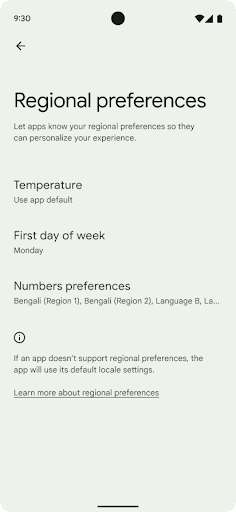
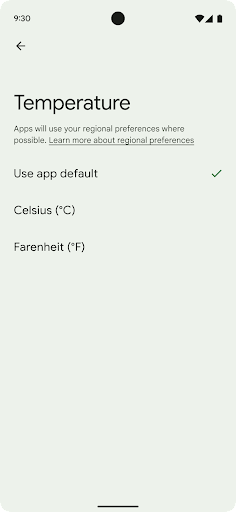
נגישות
הגדלה לא לינארית של הגופן עד 200%
החל מ-Android 14, המערכת תומכת בהגדלת הגופן עד 200%, וכך מספקת למשתמשים אפשרויות נגישות נוספות.
כדי למנוע מצביעה של אלמנטים גדולים של טקסט במסך להיות גדולה מדי, אפליקציית המערכת משתמשת בעקומת שינוי גודל לא לינארית. משמעות אסטרטגיית ההתאמה הזו היא שטקסט גדול לא מותאם באותו קצב כמו טקסט קטן יותר. שינוי גודל גופן לא לינארי עוזר לשמור על ההיררכיה הפרופורציונלית בין רכיבים בגדלים שונים, וגם לצמצם בעיות שקשורות לשינוי גודל טקסט לינארי במידות גבוהות (למשל, טקסט שנחתך או טקסט שקשה יותר לקרוא בגלל גדלים גדולים במיוחד של המסך).
בדיקת האפליקציה באמצעות שינוי גודל גופן לא לינארי
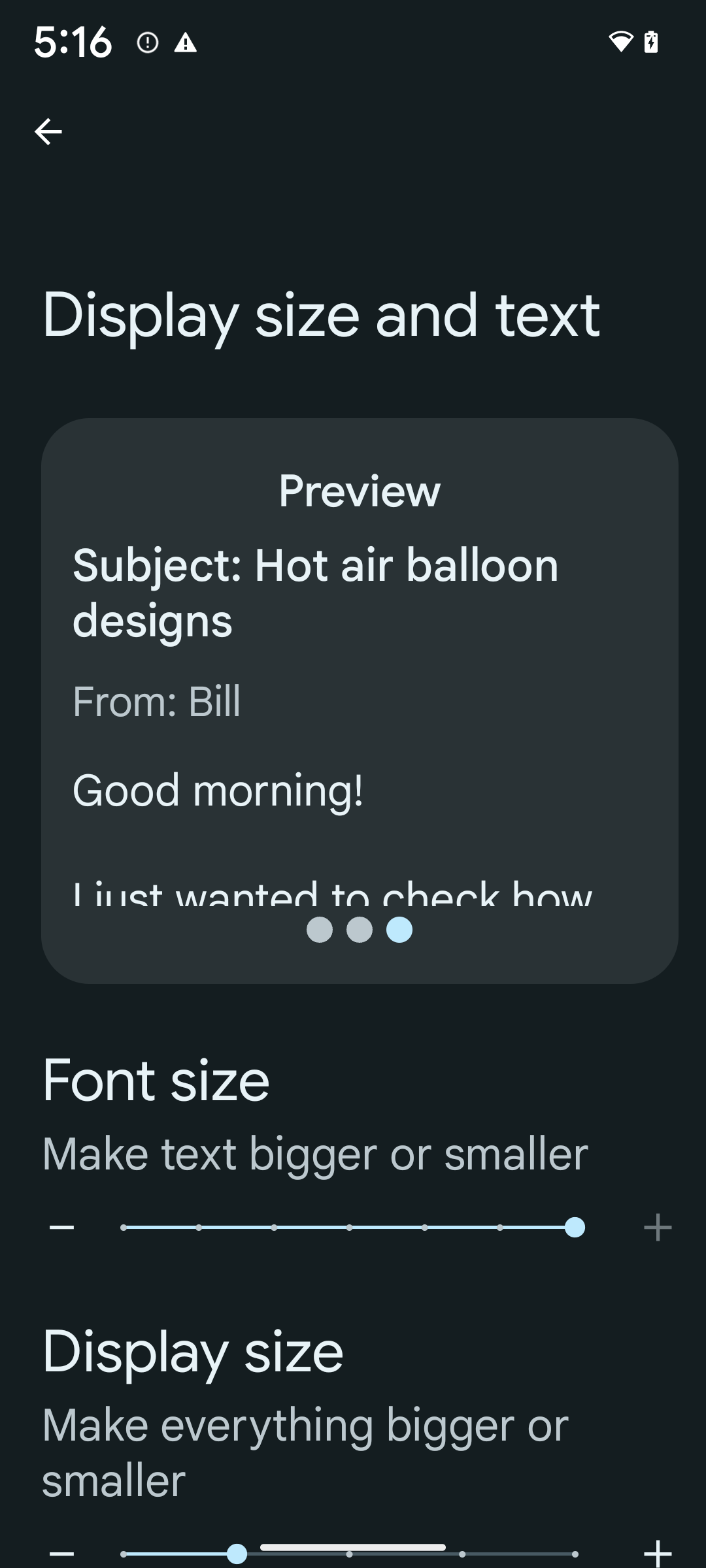
אם כבר השתמשתם ביחידות של פיקסלים שניתן לשנות (sp) כדי להגדיר את גודל הטקסט, האפשרויות הנוספות האלה והשיפורים בהתאמת הגודל יחולו באופן אוטומטי על הטקסט באפליקציה. עם זאת, עדיין מומלץ לבצע בדיקות של ממשק המשתמש עם גודל הגופן המקסימלי (200%) כדי לוודא שהאפליקציה מגדירה את גדלי הגופן בצורה נכונה, ושהיא יכולה להכיל גדלים גדולים יותר של גופן בלי לפגוע בשימושיות.
כדי להגדיר את גודל הגופן ל-200%, פועלים לפי השלבים הבאים:
- פותחים את אפליקציית ההגדרות ועוברים אל נגישות > גודל התצוגה והטקסט.
- באפשרות גודל גופן, מקישים על סמל הפלוס (+) עד שמפעילים את הגדרת גודל הגופן המקסימלי, כמו שמוצג בתמונה שמצורפת לקטע הזה.
שימוש ביחידות של פיקסלים משוקללים (sp) לגדלים של טקסט
חשוב לזכור להגדיר תמיד את גודל הטקסט ביחידות sp. כשהאפליקציה משתמשת ביחידות sp, מערכת Android יכולה להחיל את גודל הטקסט המועדף על המשתמש ולשנות את קנה המידה שלו בהתאם.
אל תשתמשו ביחידות sp למרווחים פנימיים או להגדרת גובה התצוגה בהנחה של מרווחים פנימיים מרומזים: בשינוי גודל לא לינארי של גופן, מימדי sp לא בהכרח יהיו פרופורציונליים, ולכן 4sp + 20sp לא בהכרח יהיו שווים ל-24sp.
המרת יחידות של פיקסלים שניתן לשנות (sp)
אפשר להשתמש ב-TypedValue.applyDimension() כדי להמיר יחידות sp לפיקסלים, וב-TypedValue.deriveDimension() כדי להמיר פיקסלים ליחידות sp. השיטות האלה מחילות באופן אוטומטי את עקומת ההתאמה הלא לינארית המתאימה.
אין להשתמש בקידוד קשיח של משוואות באמצעות התגים
Configuration.fontScale או
DisplayMetrics.scaledDensity. ההתאמה של גודל הגופן היא לא ליניארית, ולכן השדה scaledDensity כבר לא מדויק. השדה fontScale
מיועד לצורכי מידע בלבד, כי הגופנים כבר לא מותאמים באמצעות ערך סקלרי יחיד.
שימוש ביחידות sp בשביל lineHeight
תמיד צריך להגדיר את android:lineHeight באמצעות יחידות sp במקום יחידות dp, כדי שגובה השורה יותאם לגודל הטקסט. אחרת, אם הטקסט הוא sp אבל lineHeight הוא dp או px, הוא לא משתנה בהתאם לגודל המסך ונראה צפוף.
TextView מתקן אוטומטית את lineHeight כדי לשמור על הפרופורציות הרצויות, אבל רק אם גם textSize וגם lineHeight מוגדרים ביחידות sp.
מצלמה ומדיה
תמונות ב-Ultra HDR
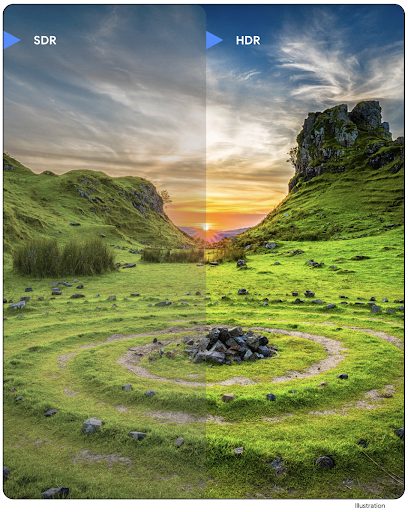
ב-Android 14 נוספה תמיכה בתמונות באיכות HDR (טווח דינמי גבוה), שמאפשרות לשמור יותר מידע מהחיישן בזמן הצילום, וכך לייצר צבעים עזים וניגודיות גבוהה יותר. ב-Android נעשה שימוש בפורמט Ultra HDR, שהוא תואם לאחור לתמונות JPEG. כך האפליקציות יכולות לפעול בצורה חלקה עם תמונות HDR ולהציג אותן בטווח דינמי סטנדרטי (SDR) לפי הצורך.
המערכת מבצעת את העיבוד של התמונות האלה בממשק המשתמש ב-HDR באופן אוטומטי כשהאפליקציה בוחרת להשתמש בממשק משתמש ב-HDR בחלון הפעילות שלה, דרך רשומה במניפסט או במהלך זמן הריצה על ידי קריאה ל-Window.setColorMode(). אפשר גם לצלם תמונות סטילס דחוסות ב-Ultra HDR במכשירים נתמכים. כשהחיישן משחזר יותר צבעים, אפשר לערוך את התמונות בצורה גמישה יותר. אפשר להשתמש ב-Gainmap שמשויך לתמונות Ultra HDR כדי ליצור רינדור שלהן באמצעות OpenGL או Vulkan.
זום, פוקוס, תצוגה מקדימה ועוד בתוספים למצלמה
ב-Android 14 יש שיפורים בתוספים למצלמה, שמאפשרים לאפליקציות להתמודד עם זמני עיבוד ארוכים יותר. כך אפשר לצלם תמונות טובות יותר באמצעות אלגוריתמים שמבוססים על חישובים כבדים, כמו צילום בתאורה חלשה במכשירים נתמכים. התכונות האלה מספקות למשתמשים חוויה חזקה עוד יותר כשהם משתמשים ביכולות של התוספים למצלמה. דוגמאות לשיפורים האלה:
- אומדן זמן האחזור הדינמי של עיבוד התמונות הסטטיות מספק אומדנים מדויקים הרבה יותר של זמן האחזור של התמונות הסטטיות, על סמך תנאי הסביבה והסצנה הנוכחיים. קוראים ל-
CameraExtensionSession.getRealtimeStillCaptureLatency()כדי לקבל אובייקטStillCaptureLatencyעם שתי שיטות להערכת זמן האחזור. השיטהgetCaptureLatency()מחזירה את זמן האחזור המשוער ביןonCaptureStartedל-onCaptureProcessStarted(), והשיטהgetProcessingLatency()מחזירה את זמן האחזור המשוער ביןonCaptureProcessStarted()לבין זמינות המסגרת הסופית שעברה עיבוד. - תמיכה בקריאות חזרה (callbacks) של התקדמות הצילום, כדי שאפליקציות יוכלו להציג את ההתקדמות הנוכחית של פעולות עיבוד ממושכות של צילומי סטילס. אפשר לבדוק אם התכונה הזו זמינה באמצעות
CameraExtensionCharacteristics.isCaptureProcessProgressAvailable. אם כן, מטמיעים את פונקציית הקריאה החוזרתonCaptureProcessProgressed(), שבה מועבר הפרמטר של ההתקדמות (מ-0 עד 100). מטא-נתונים ספציפיים לתוסף, כמו
CaptureRequest.EXTENSION_STRENGTHכדי להזין את מידת האפקט של התוסף, למשל מידת הטשטוש של הרקע באמצעותEXTENSION_BOKEH.התכונה 'תצוגה לאחר הצילום' לצילום סטילס בתוספים למצלמה, שמספקת תמונה שעברה עיבוד פחות מאשר התמונה הסופית, במהירות גבוהה יותר. אם תוסף מאריך את זמן האחזור לעיבוד, אפשר לספק תמונה שלאחר הצפייה כתמונה זמנית כדי לשפר את חוויית המשתמש, ולאחר מכן להחליף אותה בתמונה הסופית. אפשר לבדוק אם התכונה הזו זמינה באמצעות
CameraExtensionCharacteristics.isPostviewAvailable. לאחר מכן תוכלו להעבירOutputConfigurationאלExtensionSessionConfiguration.setPostviewOutputConfiguration.תמיכה ב-
SurfaceViewשמאפשרת נתיב עיבוד נתונים יעיל יותר וחסכוני יותר באנרגיה לתצוגה מקדימה.תמיכה בהקשה כדי להתמקד ובשינוי מרחק התצוגה במהלך השימוש בתוסף.
זום בחיישן
כשהערך של REQUEST_AVAILABLE_CAPABILITIES_STREAM_USE_CASE ב-CameraCharacteristics מכיל את הערך SCALER_AVAILABLE_STREAM_USE_CASES_CROPPED_RAW, האפליקציה יכולה להשתמש ביכולות המתקדמות של החיישן כדי לספק לזרם RAW חתוך את אותם הפיקסלים כמו שדה הראייה המלא, באמצעות CaptureRequest עם יעד RAW שבו מוגדרת תרחיש לדוגמה של שידור כ-CameraMetadata.SCALER_AVAILABLE_STREAM_USE_CASES_CROPPED_RAW.
הטמעת אמצעי הבקרה של ביטול הבקשה מאפשרת למשתמשי המצלמה המעודכנת לשלוט בהגדרת הזום עוד לפני שפקדי המצלמה האחרים מוכנים.
אודיו ב-USB ללא אובדן נתונים
ב-Android 14 יש תמיכה בפורמטים של אודיו ללא אובדן נתונים, כדי שתוכלו ליהנות מחוויית אודיו ברמה גבוהה באמצעות אוזניות קוויות עם חיבור USB. אפשר לשלוח שאילתה למכשיר USB כדי לקבל את מאפייני המיקסר המועדפים שלו, לרשום מאזין לשינויים במאפייני המיקסר המועדפים ולהגדיר את מאפייני המיקסר באמצעות הכיתה AudioMixerAttributes. המחלקה הזו מייצגת את הפורמט, כמו מסכת הערוץ, קצב הדגימה וההתנהגות של מיקסר האודיו. הסוג הזה מאפשר לשלוח אודיו ישירות, בלי ערבוב, שינוי עוצמת קול או עיבוד אפקטים.
פרודוקטיביות וכלים למפתחים
מנהל פרטי הכניסה
ב-Android 14 נוספה התמיכה ב-Credential Manager כ-API בפלטפורמה, עם תמיכה נוספת במכשירי Android 4.4 (רמת API 19) דרך ספריית Jetpack באמצעות Google Play Services. המטרה של Credential Manager היא להקל על המשתמשים להיכנס באמצעות ממשקי API שמאחזרים ומאחסנים את פרטי הכניסה באמצעות ספקי פרטי כניסה שהמשתמשים מגדירים. Credential Manager תומך במספר שיטות כניסה, כולל שם משתמש וסיסמה, מפתחות גישה ופתרונות כניסה מאוחדת (כמו 'כניסה באמצעות חשבון Google') בממשק API אחד.
למפתחות הגישה יש יתרונות רבים. לדוגמה, מפתחות הגישה מבוססים על תקנים מקובלים בתחום, יכולים לפעול במגוון מערכות הפעלה וסביבות עסקיות בדפדפנים, ואפשר להשתמש בהם גם באתרים וגם באפליקציות.
למידע נוסף, עיינו במסמכי העזרה בנושא Credential Manager ומפתחות גישה ובפוסט בבלוג בנושא Credential Manager ומפתחות גישה.
Health Connect
Health Connect 是用户健康与健身数据的设备端仓库。借助该功能,用户可以在一个位置控制要与这些应用共享哪些数据,并在自己喜爱的应用之间共享数据。
在搭载 Android 14 之前的 Android 版本的设备上,Health Connect 可作为应用从 Google Play 商店下载。从 Android 14 开始,Health Connect 将成为 Android 平台的一部分,并通过 Google Play 系统更新接收更新,而无需单独下载。这样一来,Health Connect 就可以频繁更新,您的应用可以依赖于搭载 Android 14 或更高版本的设备上提供的 Health Connect。用户可以通过设备的“设置”访问 Health Connect,隐私控制功能集成到系统设置中。
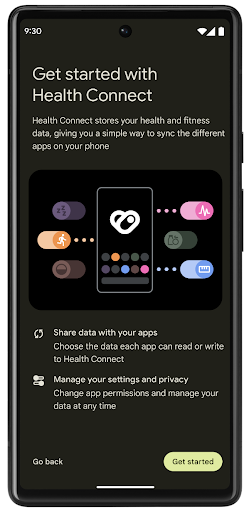
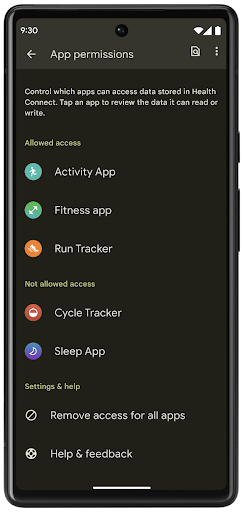
Health Connect 在 Android 14 中包含多项新功能,例如锻炼路线,可让用户分享可在地图上直观呈现的锻炼路线。路线定义为在一定时间范围内保存的位置列表,您的应用可以将路线插入锻炼时段,将它们关联起来。为确保用户能够完全控制此类敏感数据,用户必须允许与其他应用共享单个路线。
如需了解详情,请参阅 Health Connect 文档以及有关 Android Health 中的新功能的博文。
עדכונים ל-OpenJDK 17
ב-Android 14 אנחנו ממשיכים לעדכן את ספריות הליבה של Android כדי להתאים אותן לתכונות בגרסאות OpenJDK LTS האחרונות, כולל עדכוני ספריות ותמיכה בשפה Java 17 למפתחי אפליקציות ופלטפורמות.
התכונות והשיפורים הבאים כלולים:
- עדכנו כ-300 כיתות
java.baseלתמיכה ב-Java 17. - Text Blocks, שמאפשרים להשתמש במחרוזות מילולית של כמה שורות בשפת התכנות Java.
- התאמת דפוסים ל-instanceof, שמאפשרת להתייחס לאובייקט כאל אובייקט מסוג ספציפי ב-
instanceofבלי משתנים נוספים. - כיתות אטומות, שמאפשרות להגביל את המחלקות והממשקים שיכולים להרחיב אותם או להטמיע אותם.
בזכות עדכוני המערכת של Google Play (Project Mainline), יותר מ-600 מיליון מכשירים יכולים לקבל את עדכוני Android Runtime (ART) האחרונים שכוללים את השינויים האלה. זהו חלק מהמחויבות שלנו לספק לאפליקציות סביבה עקבית ומאובטחת יותר במכשירים שונים, ולספק למשתמשים תכונות ויכולות חדשות ללא קשר למהדורות הפלטפורמה.
Java ו-OpenJDK הם סימנים מסחריים או סימנים מסחריים רשומים של Oracle ו/או של השותפים העצמאיים שלה.
שיפורים בחנויות אפליקציות
ב-Android 14 נוספו כמה ממשקי API של PackageInstaller שמאפשרים לחנויות האפליקציות לשפר את חוויית המשתמש שלהן.
בקשה לאישור התקנה לפני ההורדה
יכול להיות שתצטרכו אישור משתמש כדי להתקין או לעדכן אפליקציה.
לדוגמה, כשתוכנית התקנה שמשתמשת בהרשאה REQUEST_INSTALL_PACKAGES מנסה להתקין אפליקציה חדשה. בגרסאות קודמות של Android, חנויות אפליקציות יכולות לבקש אישור מהמשתמש רק אחרי שקבצי ה-APK נכתבים בסשן ההתקנה והסשן מוגדר.
החל מ-Android 14, השיטה requestUserPreapproval() מאפשרת למתקינים לבקש אישור מהמשתמשים לפני ביצוע סשן ההתקנה. השיפור הזה מאפשר לחנות אפליקציות לדחות את הורדת חבילות ה-APK עד שהמשתמש יאשר את ההתקנה. בנוסף, אחרי שהמשתמש מאשר את ההתקנה, חנות האפליקציות יכולה להוריד ולהתקין את האפליקציה ברקע בלי להפריע למשתמש.
לטעון לבעלות על עדכונים עתידיים
השיטה setRequestUpdateOwnership() מאפשרת למתקין להציין למערכת שהוא מתכוון להיות אחראי על עדכונים עתידיים לאפליקציה שהוא מתקין. היכולת הזו מאפשרת לאכוף את הבעלות על העדכון, כלומר רק בעל העדכון רשאי להתקין עדכונים אוטומטיים לאפליקציה. אכיפת הבעלות על העדכון עוזרת לוודא שהמשתמשים מקבלים עדכונים רק מחנות האפליקציות הצפויה.
כל מתקין אחר, כולל אלה שמשתמשים בהרשאה INSTALL_PACKAGES, צריך לקבל אישור מפורש מהמשתמש כדי להתקין עדכון. אם משתמש מחליט להמשיך עם עדכון ממקור אחר, הבעלות על העדכון אבודה.
עדכון אפליקציות בזמנים פחות מפריעים
בדרך כלל, בחנויות האפליקציות לא רוצים לעדכן אפליקציה שבשימוש פעיל, כי זה מוביל לסגירת התהליכים שפועלים באפליקציה, ויכול להפריע למה שהמשתמש עושה.
החל מ-Android 14, ממשק ה-API של InstallConstraints מאפשר למתקינים לוודא שהעדכונים של האפליקציות שלהם מתבצעים בזמן המתאים. לדוגמה, חנות אפליקציות יכולה להפעיל את השיטה commitSessionAfterInstallConstraintsAreMet() כדי לוודא שהעדכון יאושר רק כשהמשתמש כבר לא יוצר אינטראקציה עם האפליקציה הרלוונטית.
התקנה חלקה של חלוקות אופציונליות
כשמשתמשים ב-APKs מפוצלים, אפשר לספק את התכונות של האפליקציה בקובצי APK נפרדים, במקום כ-APK מונוליתי. קובצי APK מפוצלים מאפשרים לחנויות אפליקציות לבצע אופטימיזציה של העברת הרכיבים השונים של האפליקציה. לדוגמה, חנויות אפליקציות עשויות לבצע אופטימיזציה על סמך המאפיינים של מכשיר היעד. ה-API של PackageInstaller תומך בחלוקות מאז ההשקה שלו ברמת API 22.
ב-Android 14, השיטה setDontKillApp() מאפשרת למנהל ההתקנה לציין שלא צריך להרוג את התהליכים שפועלים באפליקציה כשמתקינים פלחים חדשים. חנויות האפליקציות יכולות להשתמש בתכונה הזו כדי להתקין בצורה חלקה תכונות חדשות של אפליקציה בזמן שהמשתמש משתמש באפליקציה.
חבילות של מטא-נתונים של אפליקציות
החל מ-Android 14, מנהל החבילות של Android מאפשר לציין מטא-נתונים של אפליקציות, כמו שיטות לאבטחת נתונים, כדי לכלול אותם בדפי החנות של האפליקציות, כמו Google Play.
זיהוי מתי משתמשים מצלמים מסך במכשיר
כדי ליצור חוויה סטנדרטית יותר לזיהוי צילומי מסך, ב-Android 14 מוצג API לזיהוי צילומי מסך ששומר על הפרטיות. ה-API הזה מאפשר לאפליקציות לרשום פונקציות קריאה חוזרת על בסיס כל פעילות. הקריאות החוזרות האלה מופעלות, והמשתמש מקבל הודעה, כשהמשתמש מצלם צילום מסך בזמן שהפעילות הזו גלויה.
חוויית משתמש
פעולות מותאמות אישית ודירוג משופר של קובץ לשיתוף
ב-Android 14 מתבצע עדכון של גיליון השיתוף של המערכת כדי לתמוך בפעולות מותאמות אישית באפליקציות ובתצוגות מקדימות מפורטות יותר של תוצאות למשתמשים.
הוספת פעולות בהתאמה אישית
ב-Android 14, האפליקציה יכולה להוסיף פעולות בהתאמה אישית לגיליון השיתוף של המערכת שהיא מפעילה.
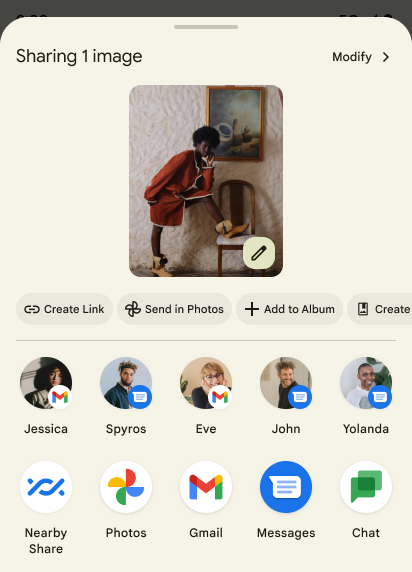
שיפור הדירוג של יעדים לשיתוף ישיר
ב-Android 14 נעשה שימוש באותות רבים יותר מאפליקציות כדי לקבוע את הדירוג של יעדי השיתוף הישיר, וכך לספק תוצאות מועילות יותר למשתמש. כדי לספק את האות הכי שימושי לדירוג, פועלים לפי ההנחיות לשיפור הדירוג של היעדים של שיתוף ישיר. אפליקציות תקשורת יכולות גם לדווח על שימוש במקשי קיצור להודעות יוצאות ונכנסות.
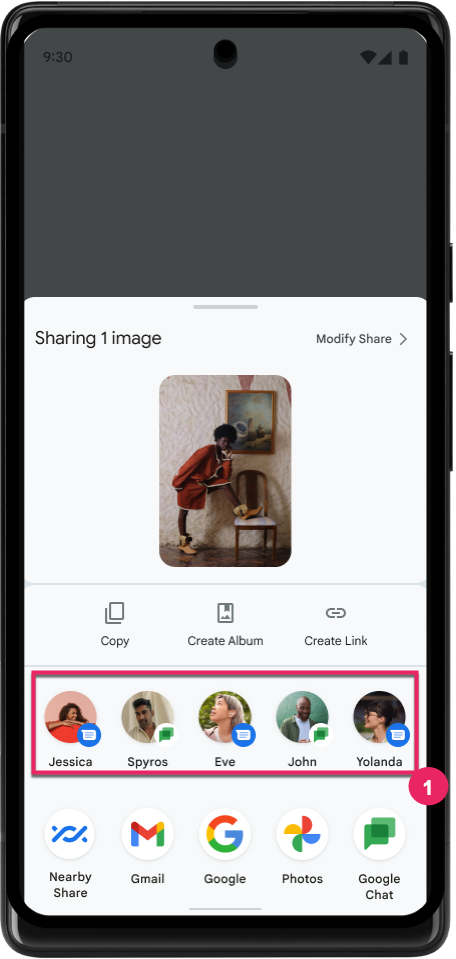
תמיכה באנימציות מובנות ומותאמות אישית לחיזוי של תנועת החזרה
Android 13 在开发者选项背后引入了预测性“返回主屏幕”动画。在已启用开发者选项的受支持应用中使用时,滑回手势会显示动画,表明返回手势会使应用退回到主屏幕。
Android 14 包含针对“预测性返回”的多项改进和新指南:
- 您可设置
android:enableOnBackInvokedCallback=true,以便为每个 activity 选择启用预测性返回系统动画,而不是为整个应用选择启用。 - 我们添加了新的系统动画,以配合 Android 13 中的“返回主屏幕”动画。新的系统动画是跨 activity 和跨任务的,您可在迁移到预测性返回后自动获得该动画。
- 我们为底部动作条、侧边动作条和搜索添加了新的 Material 组件动画。
- 我们制作了有关如何创建自定义应用内动画和转换的设计指南。
- 我们添加了许多新 API 来支持自定义的应用内转换动画:
在此 Android 14 预览版中,所有预测性返回功能都是位于开发者选项背后。请参阅与将您的应用迁移到预测性返回有关的开发者指南,以及与创建自定义应用内转换有关的开发者指南。
ביטולים של הגדרות ברירת המחדל לכל אפליקציה בנפרד על ידי יצרן מכשיר עם מסך גדול
שינוי הגדרות ברמת האפליקציה מאפשר ליצרני המכשירים לשנות את ההתנהגות של האפליקציות במכשירים עם מסך גדול. לדוגמה, ההחרגה FORCE_RESIZE_APP מורה למערכת לשנות את גודל האפליקציה כך שיתאים למימדי המסך (מבלי להשתמש במצב תאימות לגודל) גם אם הערך resizeableActivity="false" מוגדר בקובץ המניפסט של האפליקציה.
השינויים מברירת המחדל נועדו לשפר את חוויית המשתמש במסכים גדולים.
מאפייני מניפסט חדשים מאפשרים להשבית חלק מהשינויים של יצרן המכשירים באפליקציה שלכם.
הגדרות ברירת מחדל שונות לכל אפליקציה למשתמשים במסכים גדולים
שינוי ההגדרות של כל אפליקציה בנפרד משנה את התנהגות האפליקציות במכשירים עם מסך גדול. לדוגמה, שינוי ברירת המחדל של יצרן המכשיר OVERRIDE_MIN_ASPECT_RATIO_LARGE מגדיר את יחס הגובה-רוחב של האפליקציה ל-16:9, ללא קשר להגדרות האפליקציה.
ב-Android 14 QPR1, משתמשים יכולים להחיל שינויים ספציפיים לאפליקציות באמצעות תפריט הגדרות חדש במכשירים עם מסך גדול.
שיתוף מסך של אפליקציה
שיתוף מסך של אפליקציה מאפשר למשתמשים לשתף חלון של אפליקציה במקום את כל מסך המכשיר במהלך הקלטת תוכן המסך.
כשמשתפים את המסך של אפליקציה, סרגל הסטטוס, סרגל הניווט, ההתראות ואלמנטים אחרים בממשק המשתמש של המערכת לא נכללים במסך המשותף. רק התוכן של האפליקציה שנבחרה ישותף.
שיתוף המסך של אפליקציות משפר את הפרודוקטיביות והפרטיות, כי הוא מאפשר למשתמשים להפעיל כמה אפליקציות אבל להגביל את שיתוף התוכן לאפליקציה אחת.
תשובה מהירה מבוססת-LLM ב-Gboard ב-Pixel 8 Pro
在搭载 12 月功能分块的 Pixel 8 Pro 设备上,开发者可以在 Gboard 中试用质量更高的智能回复,这些回复由在 Google Tensor 上运行的设备端大语言模型 (LLM) 提供支持。
此功能目前仅在 WhatsApp、Line 和 KakaoTalk 中以美式英语的形式提供给用户进行小范围测试。此功能需要使用 Pixel 8 Pro 设备,并将 Gboard 用作键盘。
如需试用此功能,请先依次前往设置 > 开发者选项 > AiCore 设置 > 启用 Aicore 持久性,启用该功能。
接下来,在受支持的应用中打开对话,即可在 Gboard 的建议栏中看到依托 LLM 的智能回复,以便回复收到的消息。
גרפיקה
אפשר להריץ שאילתות על נתיבים ולבצע אינטרפולציה שלהם
Android 的 Path API 是一种强大且灵活的机制,可用于创建和渲染矢量图形,能够描边或填充路径、根据线段或二次曲线或立方曲线构建路径、执行布尔运算以获取更复杂的形状,或同时执行所有这些操作。但有一个限制是,您无法了解 Path 对象中实际包含的内容;该对象的内部信息在创建后对调用方是不透明的。
如需创建 Path,您可以调用 moveTo()、lineTo() 和 cubicTo() 等方法来添加路径段。但是,无法询问该路径有哪些片段,因此您必须在创建时保留该信息。
从 Android 14 开始,您可以查询路径以了解其内部内容。首先,您需要使用 Path.getPathIterator API 获取 PathIterator 对象:
Kotlin
val path = Path().apply { moveTo(1.0f, 1.0f) lineTo(2.0f, 2.0f) close() } val pathIterator = path.pathIterator
Java
Path path = new Path(); path.moveTo(1.0F, 1.0F); path.lineTo(2.0F, 2.0F); path.close(); PathIterator pathIterator = path.getPathIterator();
接下来,您可以调用 PathIterator 逐个遍历片段,并检索每个片段的所有必要数据。以下示例使用了 PathIterator.Segment 对象,它会为您打包数据:
Kotlin
for (segment in pathIterator) { println("segment: ${segment.verb}, ${segment.points}") }
Java
while (pathIterator.hasNext()) { PathIterator.Segment segment = pathIterator.next(); Log.i(LOG_TAG, "segment: " + segment.getVerb() + ", " + segment.getPoints()); }
PathIterator 还有一个非分配版 next(),您可以在其中传入缓冲区来保存点数据。
查询 Path 数据的一个重要用例是插值。例如,您可能想在两个不同的路径之间添加动画(或变形)。为了进一步简化该用例,Android 14 针对 Path 还包含 interpolate() 方法。假设两个路径具有相同的内部结构,interpolate() 方法会使用该插值结果创建一个新的 Path。以下示例返回了一个形状介于 path 和 otherPath 之间的一半(线性插值为 0.5)的路径:
Kotlin
val interpolatedResult = Path() if (path.isInterpolatable(otherPath)) { path.interpolate(otherPath, .5f, interpolatedResult) }
Java
Path interpolatedResult = new Path(); if (path.isInterpolatable(otherPath)) { path.interpolate(otherPath, 0.5F, interpolatedResult); }
Jetpack graphics-path 库也为早期版本的 Android 启用了类似的 API。
רשתות מותאמות אישית עם הצללות של קודקודים ושל פרגמנטים
כבר זמן רב יש ב-Android תמיכה בציור של רשתות משולשים עם הצללה בהתאמה אישית, אבל פורמט הרשת של הקלט היה מוגבל למספר שילובים מוגדרים מראש של מאפיינים. ב-Android 14 נוספה תמיכה במערכות רשת מותאמות אישית, שאפשר להגדיר כמשולשיים או כרצועות משולשים, ואפשר גם להוסיף אותן לאינדקס. המרקשים האלה מצוינים באמצעות מאפיינים מותאמים אישית, צעדים של קודקודים, משתנים ושגיאות של קודקודים וחלקיקים שנכתבו ב-AGSL.
ב-vertex shader מוגדרים המשתנים, כמו המיקום והצבע, ואילו ב-fragment shader אפשר להגדיר את הצבע של הפיקסל, בדרך כלל באמצעות המשתנים שנוצרו על ידי ה-vertex shader. אם הצבע מסופק על ידי ה-fragment shader, הוא מעורבב עם הצבע הנוכחי של Paint באמצעות מצב המיזוג שנבחר בזמן ציור המכסה. אפשר להעביר מאפיינים אחידים לשדרוגים של הפיקסלים והקודקודים כדי לקבל גמישות נוספת.
מעבד מאגר נתונים זמני של חומרה ל-Canvas
כדי לעזור לכם להשתמש ב-API של Canvas ב-Android כדי לצייר עם האצת חומרה ב-HardwareBuffer, ב-Android 14 הוספנו את HardwareBufferRenderer. ה-API הזה
שימושי במיוחד כאשר התרחיש לדוגמה כולל תקשורת עם המערכת
קומפוזיציה עד SurfaceControl עם זמן אחזור קצר
שרטוט.

